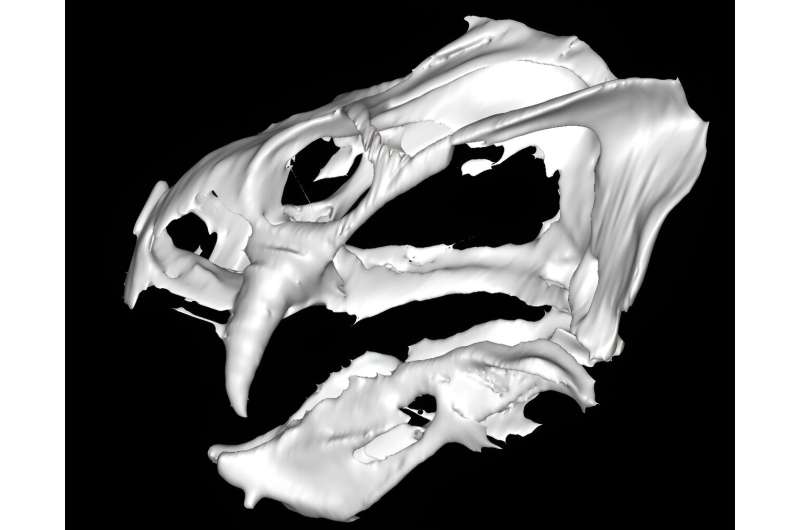This article has been reviewed according to Science X's editorial process and policies. Editors have highlighted the following attributes while ensuring the content's credibility:
fact-checked
peer-reviewed publication
trusted source
proofread
250-million-year-old fossil seen anew with modern technology

Details of an ancient cousin of modern-day mammals are being revealed for the first time. Hi-tech scanning of an ancient fossil, which was captured in sandstone around 252–254 million years ago, is giving experts valuable insight into the animal's anatomy and evolution.
The study
, published in the Zoological Journal of the Linnean Society, was carried out in collaboration with the North Carolina Museum of Natural Sciences, the University of Birmingham, and the Hunterian Museum. The pig-like, tusked animal, which belonged to a species called Gordonia traquairi, lived in a time before the dinosaurs, when Earth was comprised of a single land mass known as Pangea. It is from an extinct group of species known as dicynodonts, which are characterized by their squat bodies, beak and tusks. These creatures lived relatively soon before the worst mass extinction event in history, the Great Dying, which occurred about 252 million years ago and eliminated much of life on Earth. The specimen, known as the Elgin Marvel, is among the best preserved of a series of fossils collected close to Elgin in the north-east of Scotland. These are collectively called the Elgin Reptiles, even though some of them, such as Gordonia, are more closely related to mammals. A team of experts led by the University of Edinburgh carried out micro-CT scans—high resolution, 3D imaging—of a cavity formed by the animal in a sandstone rock, before its bones degraded. Their scans offer a three-dimensional representation of the anatomy of the skull, including details of the brain. These insights can aid understanding of the animal's likely behaviors and the biology underlying them, offering clues on the evolution of this and other species. The animal shares many physical characteristics with similar fossils found in China, indicating that the dicynodonts were diversifying across the globe shortly before the cataclysmic Great Dying. The Elgin Reptiles represent the only known example of this type of fossil in Western Europe. Researchers hope that the increasing use of micro-CT scanning as a tool to examine fossils in detail, in combination with a trend towards open sharing of data, will offer opportunities to add to the body of knowledge in the discipline. "The Elgin Marvel is a fascinating fossil of an ancient mammal relative that is among the best preserved of the world-renowned Elgin Reptiles," says Hady George, former masters in paleontology and geobiology research student, School of GeoSciences, currently of the University of Bristol. "These famous fossils were mostly found over a century ago, and it's only now that new technologies are allowing us to final reveal them in detail, and glean valuable insights into their skull and brain anatomy as well as their genealogy," "As hard as it is to imagine, around 250 million years ago Scotland was a desert covered in
More information: Hady George et al, Micro-CT data reveal new information on the craniomandibular and neuroanatomy of the dicynodont Gordonia (Therapsida: Anomodontia) from the late Permian of Scotland, Zoological Journal of the Linnean Society (2024). DOI: 10.1093/zoolinnean/zlae065
Journal information: Zoological Journal of the Linnean Society
Provided by University of Edinburgh




















